AMD Kaveri Review: A8-7600 and A10-7850K Tested
by Ian Cutress & Rahul Garg on January 14, 2014 8:00 AM ESTCPU Performance: Continued
Xilisoft Video Converter 7 - link
The XVC test I normally do is updated to the full version of the software, and this time a different test as well. Here we take two different videos: a double UHD (3840x4320) clip of 10 minutes and a 640x266 DVD rip of a 2h20 film and convert both to iPod suitable formats. The reasoning here is simple – when frames are small enough to fit into memory, the algorithm has more chance to apply work between threads and process the video quicker. Results shown are in seconds and time taken to encode. XVC also offers acceleration via CUDA and AMD APP, so if these are available on the CPU we offer results with and without.
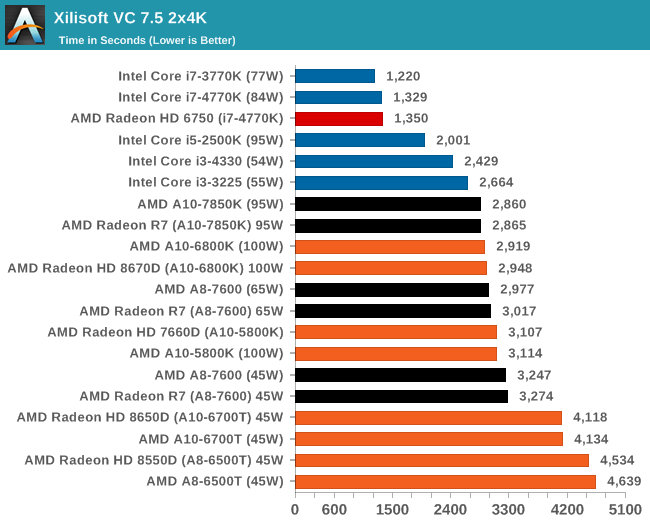
With large frame data, the IGP on Kaveri does not particularly help much.

For smaller frames however, there is an advantage to enabling the AMD APP function.
HandBrake v0.9.9 - link
For HandBrake we do the same files as XVC but convert them into the default format Handbrake offers upon loading the software. Results shown are in Frames Per Second.

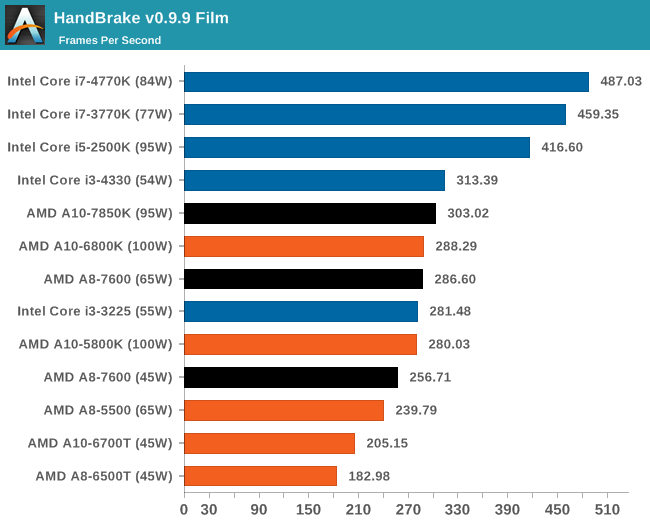
Handbrake loves cores, threads and MHz
Adobe After Effects 6
Published by Adobe, After Effects is a digital motion graphics, visual effects and compositing software package used in the post-production process of filmmaking and television production. For our benchmark we downloaded a common scene in use on the AE forums for benchmarks and placed it under our own circumstances for a repeatable benchmark. We generate 152 frames of the scene and present the time to do so based purely on CPU calculations.

7-Zip 9.2 - link
As an open source compression tool, 7-Zip is a popular tool for making sets of files easier to handle and transfer. The software offers up its own benchmark, to which we report the result.
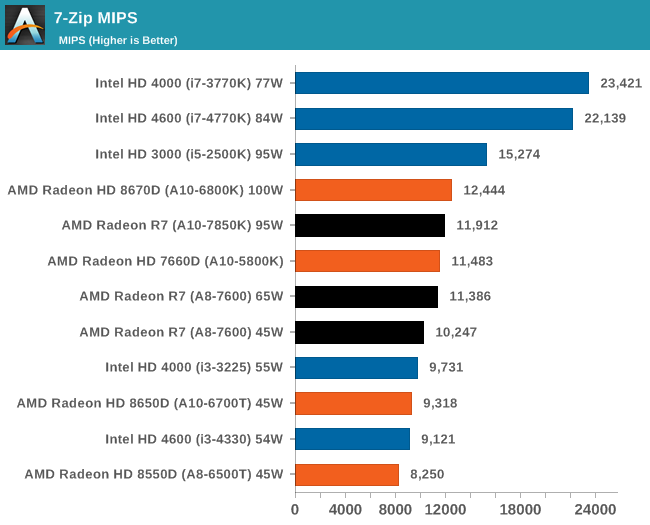
PovRay 3.7 - link
PovRay historically loves threads, MHz and IPC. The standard benchmark from PovRay is what we use to test here.
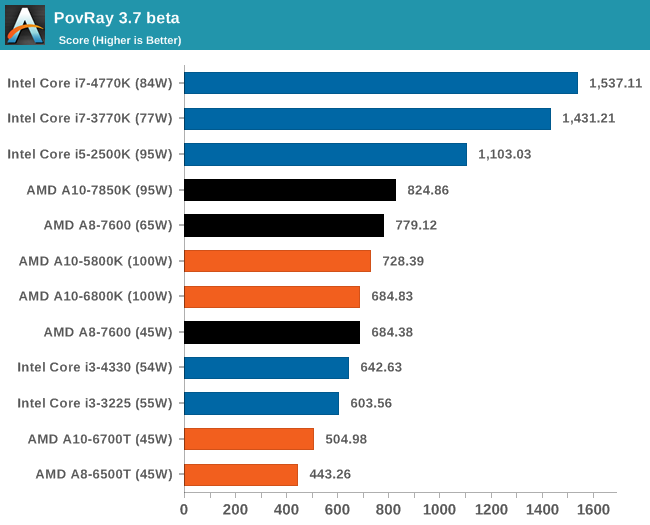
TrueCrypt 7.1a - link
TrueCrypt is an off the shelf open source encoding tool for files and folders. For our test we run the benchmark mode using a 1GB buffer and take the mean result from AES encryption.
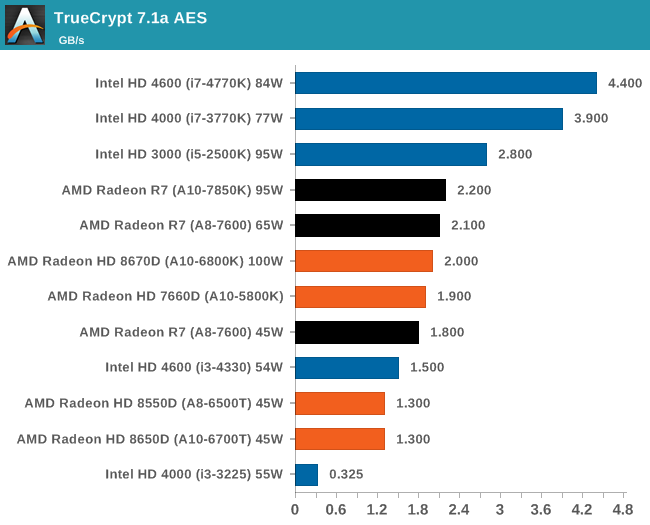










380 Comments
View All Comments
boozed - Tuesday, January 14, 2014 - link
You must be a hoot at parties.boozed - Wednesday, January 15, 2014 - link
And I hit reply on the wrong bloody comment. My apologies...monsieurrigsby - Wednesday, January 29, 2014 - link
I'm a bit slow to the party, but talk of discrete GPUs leads me to the main question I still have that I don't see explained (possibly because the authors assume deeper understanding of CPU/GPU programming), and haven't seen discussed elsewhere. (I've not looked *that* hard...)If you have a Kaveri APU and a mid/high-end discrete GPU that won't work with Dual Graphics (if it arrives), what processing can and can't use the on-APU GPU? If we're talking games (the main scenario), what can developers offload onto the onboard GPU and what can't they? What depends on the nature of the discrete card (e.g., are modern AMD ones 'HSA enabled' in some way?)? If you *do* have a Dual Graphics capable discrete GPU, does this still limit what you can *explicitly* farm off to the onboard GPU?
My layman's guess is that GPU compute stuff can still be done but, without dual graphics, stuff to do with actual frame rendering can't. (I don't know enough about GPU programming to know how well-defined that latter bit is...)
It's just that that seems the obvious question for the gaming consumer: if I have a discrete card, in what contexts is the on-APU GPU 'wasted' and when could it be used (and how much depends on what the discrete card is)? And I guess the related point is how much effort is the latter, and so how likely are we to see elements of it?
Am I missing something that's clear?
monsieurrigsby - Wednesday, January 29, 2014 - link
Plus detail on Mantle seems to suggest that this might provide more control in this area? But are there certain types of things which would be *dependent* on Mantle?http://hothardware.com/News/How-AMDs-Mantle-Will-R...
nissangtr786 - Tuesday, January 14, 2014 - link
I told amd fanboys the fpu on intel and the raw mflops mips ofintel cpu destroy current a10 apus, its no real suprise all those improvement show very little in benchmarks with kaveri steamroller cores. amd fanboys said it will reach i5 2500k performance, I said i3 4130 but overall i3 4130 will be faster in raw performance and I am right. I personally have an i5 4430 and it looks like i5's still destroy these a10 apu in raw performance.http://browser.primatelabs.com/geekbench3/326781
browser.primatelabs.com/geekbench3/321256
a10-7850k Sharpen Filter Multi-core 5846 4.33 Gflops
browser.primatelabs.com/geekbench3/321256
i5 4430 Sharpen Filter Multi-core 11421 8.46 Gflops
gngl - Tuesday, January 14, 2014 - link
"I personally have an i5 4430 and it looks like i5's still destroy these a10 apu in raw performance."You seem to have a very peculiar notion of what "raw performance" means, if you're measuring it in terms of what one specific benchmark does with one specific part of the chip. There's nothing raw about a particular piece of code executing a specific real-world benchmark using a particular sequence of instructions.
chrnochime - Tuesday, January 14, 2014 - link
Who cares what CPU you have anyway. If you want to show off, tell us you have at least a 4670k and not a 4430. LOLkeveazy - Tuesday, January 14, 2014 - link
It's relevant that he used the i5 4430 in his comment. Compare the price range and you'll see. These AMD apu's are useless unless your just looking to build a PC that's not meant to handle heavily threaded tasks.tcube - Thursday, January 16, 2014 - link
Ok... heavily threaded tasks ok... examples! Give me one example of one software 90% of pc users use 90% of the time that this apu can't handle... then and ONLY then is the cpu relevant! Other then that it's just bragging rights and microseconds nobody cares about on a PC!Instead we do care to have a chip that plays anything from hd video to AAA 3d games and also is fast enough for anything else and don't need a gpu for extra cost, power usage heat and noise! And that ain't any intel that fits on a budget!
keveazy - Saturday, January 18, 2014 - link
I'll give you 1 example. Battlefield 4.